 |
 |
|
Catalogue of the Cosmos
|
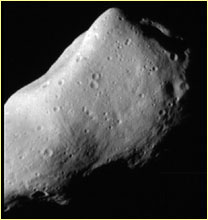 Asteroid 951 Gaspra
Asteroid 951 Gaspra
|
Accretion—The collection of material together to form a star, planet, or
moon, usually mediated by a rotating disk.
Active galaxy—A galaxy with an unusually strong output of energy, thought to
be powered by a supermassive black hole in its core.
Andromeda Galaxy—The nearest large spiral galaxy to the Milky Way, about 2.5
million light years away. Also known as M31.
|
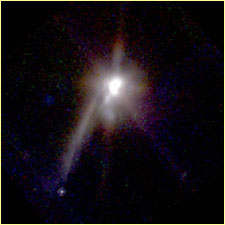 Newborn binary stars as seen by NASA's Near
Infrared Camera and Multi-Object Spectrometer
Newborn binary stars as seen by NASA's Near
Infrared Camera and Multi-Object Spectrometer
|
Antimatter—Matter made of particles with the same mass as the corresponding
particles of conventional matter, but with an opposite electrical charge.
Asteroid—A small rocky or metallic body that orbits a star.
Asteroid belt—The region of the solar system where most of the asteroids
orbit. It lies between the orbits of Mars and Jupiter.
|
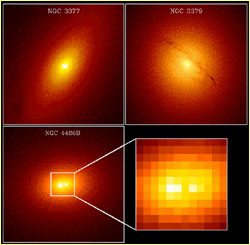 Galaxies possibly containing black holes, which can appear
bright as they suck in all nearby light.
Galaxies possibly containing black holes, which can appear
bright as they suck in all nearby light.
|
Big bang—The fiery birth of the observable universe in an explosion of space
itself, which occurred at some time between 12 and 15 billion years ago.
According to the prevailing theory, the big bang launched the observed
expansion of the universe that continues to this day.
Binary star system—Two stars orbiting their common center of gravity.
Black hole—A region in space where gravity is so strong that space closes
back on itself, allowing nothing, not even light, to escape.
|
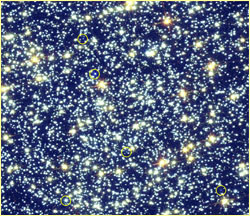 Composite of Hubble Space
Telescope images of globular cluster 47 Tucanae, which contains many blue
stragglers (seen here as blue dots within yellow circles)
Composite of Hubble Space
Telescope images of globular cluster 47 Tucanae, which contains many blue
stragglers (seen here as blue dots within yellow circles)
|
Blue straggler—A star that forms in a globular cluster from the collision or
merger of two stars. It is hotter and bluer than its non-coalesced
counterparts.
Brown dwarf—An astronomical object with mass in the range between a planet
and a star (greater than 1.3 percent and less than 8 percent the mass of the
sun). Brown dwarfs have a brief phase of weak nuclear fusion of deuterium
(heavy hydrogen), but never become hot enough to fuse hydrogen, as do
stars.
Circumstellar disk—Dust and gas forming a disk in orbit around a star. Some
circumstellar disks may contain planetary systems.
|
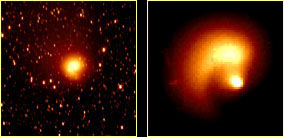 Comet Hale-Bopp as seen by the Hubble Space
Telescope
Comet Hale-Bopp as seen by the Hubble Space
Telescope
|
Comet—A small solar system body made of ice and dust that moves in an
elliptical orbit around the sun. A typical comet has a solid nucleus a few
kilometers in diameter. When it nears the inner solar system, ices evaporate
and form an extended and diffuse atmosphere, which is blown away from the sun
by the solar wind and radiation pressure to form a prominent tail of gas and
dust.
Cosmic background radiation—The microwave energy observed from all
directions in the sky, at an equivalent temperature of 2.7 degrees above
absolute zero, and interpreted as the residual glow from the big bang.
Cosmic rays—Fast-moving, high-energy, subatomic particles, mainly protons,
that permeate the galaxy.
|
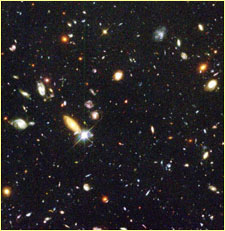 An elliptical
concentration of stars in globular cluster M15
An elliptical
concentration of stars in globular cluster M15
|
Dark matter—Unseen matter that is detected only by its gravitational pull on
visible matter. Most of the universe is evidently made of dark matter. Its
nature is yet to be determined.
Dark matter halo—A roughly spherical halo of dark matter that surrounds a
galaxy, including the Milky Way, and extends far beyond the region of luminous
stars.
Dwarf galaxy—The smallest and most common kind of galaxy.
|
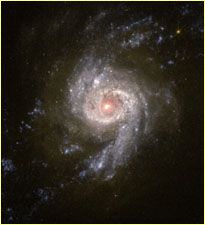 A Hubble Wide Field
Planetary Camera 2 image of Galaxy NGC 3310
A Hubble Wide Field
Planetary Camera 2 image of Galaxy NGC 3310
|
Elliptical galaxy—A galaxy that appears round or elliptical and lacks a disk
with spiral arms. Such galaxies have little dust and gas, and show few signs of
ongoing star formation.
Galactic disk—The flat disk of a spiral galaxy, which includes young stars
and the gas and dust clouds from which they are formed.
Galaxy—A massive, gravitationally bound assembly of stars, interstellar
clouds, and dark matter.
|
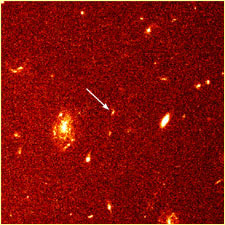 GRB 971214 field, about four
months after a gamma-ray burst, as seen by the Hubble Space
Telescope
GRB 971214 field, about four
months after a gamma-ray burst, as seen by the Hubble Space
Telescope
|
Gamma rays—Highly energetic photons, having the shortest wavelengths and the
highest frequencies in the electromagnetic spectrum.
Gamma-ray burst—Sudden, unpredictable flashes of high-energy photons coming
from space.
Gas-giant planet—A giant planet with a massive and deep atmosphere that
surrounds a relatively small rocky core.
|
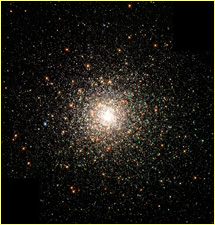 Located about 28,000 light-years from Earth, M-80 (NGC 6093) is one of the densest of 147
known globular clusters in the Milky Way.
Located about 28,000 light-years from Earth, M-80 (NGC 6093) is one of the densest of 147
known globular clusters in the Milky Way.
|
Globular cluster—A dense spherical cluster of hundreds of thousands of stars
bound together by gravity.
Giant star—A highly luminous star, approaching the end of its life, with an
extended, tenuous atmosphere surrounding a hot core depleted in
hydrogen.
Gravitational waves—Disturbances or ripples in the fabric of space produced
by violent events in the cosmos.
|
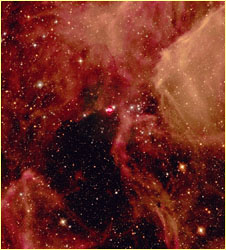 A Hubble Space Telescope image of supernova 1987A, in the Large Magellanic
Cloud
A Hubble Space Telescope image of supernova 1987A, in the Large Magellanic
Cloud
|
Kuiper Belt—A donut-shaped region of comets in orbit beyond Neptune, assumed
to be the oldest surviving remnant of the original solar nebula and the source
of short-period comets.
Kuiper Belt objects (KBOs)—The comets that populate the Kuiper Belt.
Local Group—A small group of about two dozen galaxies, including its two
largest members, the Milky Way and the Andromeda Galaxy.
|
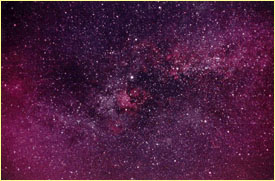 The Milky Way galaxy as seen from the
Northern Hemisphere
The Milky Way galaxy as seen from the
Northern Hemisphere
|
Long-period comet—A comet with an orbital period exceeding about 200 years.
Such long-period comets have very elongated elliptical orbits, and can have
periods of more than a million years. They originate from the Oort cloud in the
outermost reaches of our solar system.
Macho (Massive Compact Halo Object)—An unseen stellar or planetary body that
may contribute to the dark matter in galaxies.
Magellanic clouds—Two irregular satellite galaxies of the Milky Way, visible
even to the naked eye in the southern skies.
|
 A nebula in host
galaxy NGC 6822, captured with Hubble's Wide Field Planetary Camera
2
A nebula in host
galaxy NGC 6822, captured with Hubble's Wide Field Planetary Camera
2
|
Meteor—A bright streak of light produced by a small fragment of rock or
metal that burns up as it enters the atmosphere.
Meteorite—A fragment of rock or metal that has landed on the Earth from
interplanetary space. Most meteorites come from the asteroids, but a few are
from other planets or satellites.
Milky Way—The faint band of light stretching across the sky, due to myriad
faint stars and nebulas; the name of the spiral galaxy containing our solar
system.
|
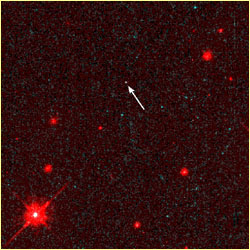 A lone neutron star, as seen
by the Hubble Space Telescope
A lone neutron star, as seen
by the Hubble Space Telescope
|
Molecular cloud—A large interstellar cloud of gas and dust with temperatures
low enough for atoms to combine as molecules. Giant molecular clouds are the
main regions of star and planet formation in galaxies.
Nebula—An immense, cloud-like mass of interstellar gas and dust, generally
in the spiral arms of a galaxy.
Neutron star—An extremely dense collapsed star consisting mainly of
neutrons. A neutron star is what often remains after the supernova explosion of
a massive star.
|
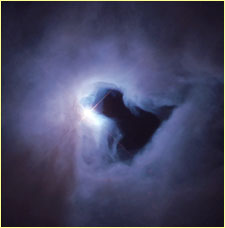 NGC 1999, a nebula in the constellation Orion, as seen
by Hubble's Wide Field Planetary Camera 2
NGC 1999, a nebula in the constellation Orion, as seen
by Hubble's Wide Field Planetary Camera 2
|
Oort cloud—A spherical cloud of trillions of comets extending about halfway
to the nearest stars and weakly bound by the sun's gravity. Long-period comets
originate from the Oort cloud.
Orion nebula—A large interstellar cloud of gas and dust giving birth to
stars in the constellation of Orion, about 1,500 light-years away.
Planet—An astronomical body with enough mass for its gravity to make it
spherical but not enough to generate nuclear energy. Planets have
non-intersecting orbits around stars or drift freely in space.
|
 A view of Africa, Madagascar, and the Arabian Peninsula from
Apollo 17
A view of Africa, Madagascar, and the Arabian Peninsula from
Apollo 17
|
Planetary nebula—An expanding shell of luminous gas that surrounds a small
white dwarf star. The ionized shell receives ultraviolet light from the hot
white dwarf and re-emits it as colorful visible light by fluorescence.
(Planetary nebula have nothing to do with planets; the term is a historical
misnomer.)
Planetesimal—One of the family of asteroid-sized bodies that first condensed
out of the disk of the solar nebula and later collided to form the
planets.
Plutino—A subclass of Kuiper Belt objects which, like Pluto, orbit the sun
twice during every three orbits of Neptune.
|
 Hubble Space Telescope image
of planetary nebula NGC 6543, the so-called "Cat's Eye Nebula"
Hubble Space Telescope image
of planetary nebula NGC 6543, the so-called "Cat's Eye Nebula"
|
Protoplanetary disk—A disk of dust, gas, and perhaps developing planets
orbiting a young star. A transitional stage between a solar nebula and a solar
system.
Protostar—A gravitationally contracting gas cloud in the early stage of star
formation, before fusion begins in its core.
Pulsar—A rapidly spinning neutron star that emits radio energy at regular
intervals and is thereby observed on Earth as a pulsating radio source.
|
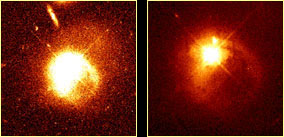 A quasar and its
companion galaxy as seen by Hubble's Wide Field Planetary Camera 2
A quasar and its
companion galaxy as seen by Hubble's Wide Field Planetary Camera 2
|
Quasar—The highly luminous core of a remote galaxy, thought to be powered by
a supermassive black hole. Quasars look like stars on an ordinary photograph
but have very different spectra.
Red giant—A large, highly luminous and relatively cool (red) star at a late
stage of its life, once it has exhausted its core hydrogen fuel.
Rogue planet—A planet-sized body that escaped its host planetary system and
is not gravitationally bound to a star.
|
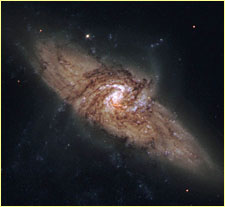 Spiral galaxy
NGC 3314 as seen by Hubble's Wide Field Planetary Camera 2
Spiral galaxy
NGC 3314 as seen by Hubble's Wide Field Planetary Camera 2
|
Short-period comet—A comet with an orbital period less than about 200 years,
the most famous example being Halley's Comet, which appears every 76 years.
Short-period comets come from the Kuiper Belt and typically orbit the sun in
the same direction as the planets.
Solar nebula—The cloud of gas and dust that formed the young sun and the
surrounding planets.
Solar system—The sun and all the objects bound to it by gravity (planets,
satellites, asteroids, comets).
|
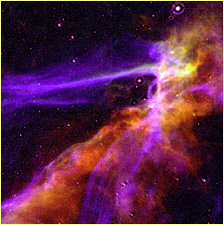 This blast wave originated in the Cygnus Loop supernova, which occurred about 15,000 years ago.
This blast wave originated in the Cygnus Loop supernova, which occurred about 15,000 years ago.
|
Spiral galaxy—A system of billions of stars with a central bulge of older
stars surrounded by a flat disk with spiral arms of gas and dust nebulas and
young stars. The Milky Way is a spiral galaxy. [For more on spiral galaxies,
see Spin a Spiral Galaxy.
Stellar wind—The outflow of charged particles that a star emits into
interstellar space.
Supercluster—A congregation of clusters of galaxies.
|
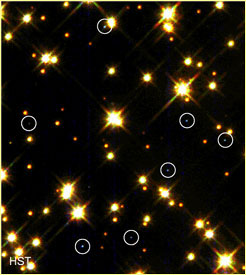 White dwarf stars in globular cluster M4 as
seen by Hubble Space Telescope
White dwarf stars in globular cluster M4 as
seen by Hubble Space Telescope
|
Supergiant—An extremely luminous star with an extended tenuous
atmosphere.
Supernova—The catastrophic explosion of a star, which blows off most of its
mass, increasing in brightness by as much as a billion times. A Type I
supernova is due to the thermonuclear detonation of a compact white dwarf star
that becomes unstable by accreting mass from an orbiting companion star. A Type
II supernova results from the gravitational collapse of a massive star that has
exhausted its nuclear fuel. [For more on supernovas, see Birth of a
Supernova.]
Trajectory—The curving path of a body in motion through space.
T Tauri star—A class of young star with variable luminosity, thought to be
in the process of gravitational contraction before its arrival at the main
sequence where it will begin to fuse hydrogen into helium.
White dwarf—The hot, collapsed core of a red giant star after it has
expelled its outer layers and ceased to produce energy by fusion. A white dwarf
has a mass comparable to that of the sun but is no larger than the Earth.
Photo credits
One Astronomer's Universe |
A Bad Day in the Milky Way
Catalogue of the Cosmos |
Tour the Spectrum
Resources |
Transcript |
Site Map |
Death Star Home
Search |
Site Map |
Previously Featured |
Schedule |
Feedback |
Teachers |
Shop
Join Us/E-Mail |
About NOVA |
Editor's Picks |
Watch NOVAs online |
To print
PBS Online |
NOVA Online |
WGBH
© | Updated January 2002
|
|
|
|